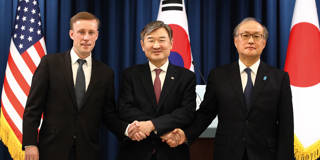Given the outsize impact of US-China competition on East Asian countries, even slightly improved bilateral ties would bode well in the near term. Nonetheless, new risks and political arrangements ensure that the region will continue to be characterized by great-power rivalry and many flashpoints.
WASHINGTON, DC – For several years, tensions in the South China Sea and Taiwan Strait, along with the heavy impact of COVID-19 among Association of Southeast Asian Nations (ASEAN) economies, have posed serious diplomatic challenges in Southeast Asia. But recent developments in Northeast Asia, including escalating tensions on the Korean Peninsula and deepening ties between North Korea and Russia, are equally troubling. A pall has been cast over the region, even as the prospects for a somewhat more stable Sino-American relationship have improved.
Still, given the outsize impact of Sino-American competition on East Asian countries, even slightly improved ties between the United States and China would bode well. US President Joe Biden and Chinese President Xi Jinping’s November 2023 meeting in San Francisco helped put a floor under an increasingly acrimonious rivalry, and the resumption of some military-to-military communications and regular diplomatic meetings among senior officials has reduced the risks of miscalculation and unintended conflict.
At the same time, expectations of slower economic growth in 2024 may dampen China’s urge to pursue a high-risk confrontation with the US or its East Asian neighbors over maritime and economic disputes. With cooling Chinese demand potentially hurting some businesses in the region, the US and other regional players might use the moment both to improve bilateral relations and to seek markets in other parts of East Asia.

WASHINGTON, DC – For several years, tensions in the South China Sea and Taiwan Strait, along with the heavy impact of COVID-19 among Association of Southeast Asian Nations (ASEAN) economies, have posed serious diplomatic challenges in Southeast Asia. But recent developments in Northeast Asia, including escalating tensions on the Korean Peninsula and deepening ties between North Korea and Russia, are equally troubling. A pall has been cast over the region, even as the prospects for a somewhat more stable Sino-American relationship have improved.
Still, given the outsize impact of Sino-American competition on East Asian countries, even slightly improved ties between the United States and China would bode well. US President Joe Biden and Chinese President Xi Jinping’s November 2023 meeting in San Francisco helped put a floor under an increasingly acrimonious rivalry, and the resumption of some military-to-military communications and regular diplomatic meetings among senior officials has reduced the risks of miscalculation and unintended conflict.
At the same time, expectations of slower economic growth in 2024 may dampen China’s urge to pursue a high-risk confrontation with the US or its East Asian neighbors over maritime and economic disputes. With cooling Chinese demand potentially hurting some businesses in the region, the US and other regional players might use the moment both to improve bilateral relations and to seek markets in other parts of East Asia.